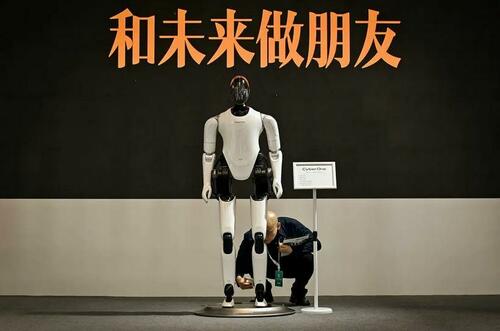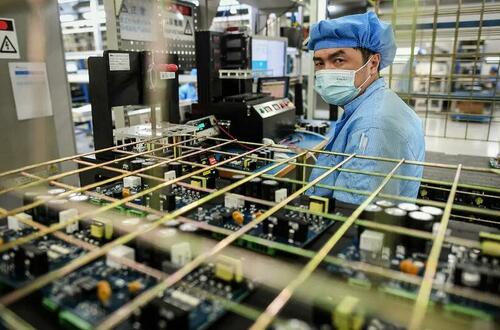
Authored by Andrew Thornebrooke via The Epoch Times (emphasis ours),
The Chinese regime has unveiled plans to mass produce humanoid robots in an apparent effort to insulate itself from reliance on foreign powers by replacing Chinese workers with machines.

The Chinese Communist Party’s (CCP) Ministry of Industry and Information Technology unveiled its plan to mass-produce humanoid robots in a November guidance document. The sweeping ramifications of the policy are still being uncovered.
The strategy aims to make the CCP the world’s leader in the field of robotics by building a “humanoid robot innovation system,” developing artificial brains and limbs by 2025, according to the document.
By using a “whole-of-nation system,” the document says, the regime can harness “disruptive” technologies to “profoundly change human production and lifestyle and reshape the global industrial development pattern.”
The move carries national security implications and, according to several reports, will help the CCP maintain economic advantage even as its population dwindles following decades of severe restrictions on childbirth.
A report by the Center for Strategic and International Studies think tank found that the regime is effectively replacing people with robots to maintain a competitive edge in labor-intensive manufacturing industries.
Communist Robots
China’s robotic push will also proliferate the CCP’s communist ideology and serve as an invaluable tool for the regime to champion its own interests.
In April, a draft proposal by the regime’s internet regulator suggested that all content generated by artificial intelligence (AI) should be mandated to “reflect the socialist core values” espoused by the CCP.
The regime’s robotic guidance document goes further.
According to the new document, all new robots and AI-powered artificial brains should be “guided by Xi Jinping Thought on Socialism with Chinese Characteristics for a New Era.”
Adam Savit, director of the China Policy Initiative at the America First Policy Institute think tank, said that the regime could use the robots to spread communist ideology throughout the global marketplace.
“They will certainly try,” Mr. Savit told The Epoch Times. “The CCP takes advantage of any and all means available, especially innovative new technologies, to spread its ideology and expand its influence.”
Mr. Savit pointed to social media giant TikTok, which is owned by the CCP-affiliated ByteDance, as “the most successful and disturbing example” of the regime’s use of technology to spread its worldview.

To counter the risk, he said, the United States needs to do more to limit the outflow of its own research and technology to China to dampen the regime’s efforts.
“There is an urgent need to curtail U.S. outbound investment into China, especially for critical high-tech sectors like AI, quantum computing, and advanced semiconductors,” Mr. Savit said.
“A Biden administration executive order limiting such investments is set to be enacted in 2024. It’s a good start but it has been criticized for vague and likely ineffective enforcement mechanisms.”
The ideological underpinnings of the robot initiative underscore two more of Beijing’s strategic policies: military-civil fusion and forced technology transfer.
Military-civil fusion, the policy through which Beijing seeks to ensure that all civil technologies also provide the party with military utility, is borne out in the guidance document’s call to “support [robot] enterprises to join forces with universities and institutions,” ensuring the regime can leverage the technology and any associated research.
Likewise, the initiative will likely increase the risk posed to U.S. companies and their intellectual property as the regime searches for ways to “encourage foreign companies and institutions to set up R&D centers in the country,” where the CCP will have access to the related data.
CCP access to foreign companies’ data is a key issue in global security because of Chinese laws that categorize data as a national resource, thereby allowing the regime to seize any information stored on servers in the country.
The push for mass adoption of humanoid robots will require untold amounts of data, as the guidance document outlines that the project will seek to build a large language model training database to train AI brains for its robots and to innovate the “automatic” annotation of new data into usable information.
Apart from data, the regime also seeks to develop its own high-end semiconductors to facilitate “motion control and cognitive decision-making” in the robots, as well as “the integration of sensing, decision-making, and control” mechanisms.
With that in mind, the regime hopes to deploy its new communist humanoid robots to operate sensitive sites where it may have reservations about using human operators.
According to the guidance document, such sites include hydropower stations, wind farms, and other critical electricity systems, as well as other “strategic locations” where “highly reliable” robots would be preferred to their less expendable human counterparts.
Capturing Global Markets
The CCP’s robotic renaissance is already well underway.
In 2022, China installed 290,000 non-humanoid industrial robots. The United States, by comparison, installed 39,000.
China has now surpassed the United States in robot density, meaning it has deployed more robots relative to workers, and the communist nation now operates the largest operational stock of robots in the world.
Such metrics are key to understanding the regime’s ability to use automation to gain economic advantage in the years to come, according to a report by the International Federation of Robotics.
“Robot density is a key indicator of automation adoption in the manufacturing industry around the world,” International Federation of Robotics President Marina Bill said.
“China’s rapid growth shows the power of its investment so far, but it still has much opportunity to automate.”
To that end, Beijing appears intent on capturing the robotic market abroad, using foreign technology and state-run research institutions to centralize power over the manufacturing process before shipping its robots worldwide.
A report by the International Institute for Strategic Studies (IISS) think tank found that the CCP seeks to earn a long-term advantage by establishing and controlling the supply chains required to create advanced robotics.

“Beijing aims both to achieve a high degree of self-sufficiency and to capture a significant share of the global market for a wide array of advanced products and components,” the report states.
This could result in the regime obtaining significant economic and military advantage in the future due to the cascading effects of being the first to mass-produce humanoid robots. By controlling the initial technology, the regime can dictate how the technology evolves.
“If it can gain an edge in what has been described as a fourth industrial revolution in manufacturing, while reducing its dependence on high-tech imports, China may be able to boost its own prospects for long-term growth while diminishing those of its competitors,” the report reads.
“Because future products and military systems will build on them, breakthroughs in technologies such as artificial intelligence could also yield enduring advantages.”
Arthur Herman, a senior fellow at the Hudson Institute think tank, said that “the really scary thing” about the regime’s guidance document is that it could lead to the CCP gaining more influence in establishing international standards and rules over AI and robotics.
“You can guess what that means: China’s robotics industry becomes the global standard, pushing aside any competition, including setting the moral standard,” Mr. Herman told The Epoch Times.
“[It’s] not a good sign if we want to have sensible and responsible standards for future development of this potentially disruptive technology [that] everyone can live with.”
Mr. Herman expressed optimism that the United States is seeing a proliferation of its own robotic companies. Still, he's worried about the nation’s lack of a coherent strategy for AI development.
“The difference is that, clearly, China sees this robot push as part of its $110 billion campaign announced in 2017 to become the world’s leading AI nation by 2030,” Mr. Herman said.
“We don’t have a national AI strategy, let alone a strategy relating to the intersection of robotics and AI.”
Read more here...
Authored by Andrew Thornebrooke via The Epoch Times (emphasis ours),
The Chinese regime has unveiled plans to mass produce humanoid robots in an apparent effort to insulate itself from reliance on foreign powers by replacing Chinese workers with machines.

The Chinese Communist Party’s (CCP) Ministry of Industry and Information Technology unveiled its plan to mass-produce humanoid robots in a November guidance document. The sweeping ramifications of the policy are still being uncovered.
The strategy aims to make the CCP the world’s leader in the field of robotics by building a “humanoid robot innovation system,” developing artificial brains and limbs by 2025, according to the document.
By using a “whole-of-nation system,” the document says, the regime can harness “disruptive” technologies to “profoundly change human production and lifestyle and reshape the global industrial development pattern.”
The move carries national security implications and, according to several reports, will help the CCP maintain economic advantage even as its population dwindles following decades of severe restrictions on childbirth.
A report by the Center for Strategic and International Studies think tank found that the regime is effectively replacing people with robots to maintain a competitive edge in labor-intensive manufacturing industries.
Communist Robots
China’s robotic push will also proliferate the CCP’s communist ideology and serve as an invaluable tool for the regime to champion its own interests.
In April, a draft proposal by the regime’s internet regulator suggested that all content generated by artificial intelligence (AI) should be mandated to “reflect the socialist core values” espoused by the CCP.
The regime’s robotic guidance document goes further.
According to the new document, all new robots and AI-powered artificial brains should be “guided by Xi Jinping Thought on Socialism with Chinese Characteristics for a New Era.”
Adam Savit, director of the China Policy Initiative at the America First Policy Institute think tank, said that the regime could use the robots to spread communist ideology throughout the global marketplace.
“They will certainly try,” Mr. Savit told The Epoch Times. “The CCP takes advantage of any and all means available, especially innovative new technologies, to spread its ideology and expand its influence.”
Mr. Savit pointed to social media giant TikTok, which is owned by the CCP-affiliated ByteDance, as “the most successful and disturbing example” of the regime’s use of technology to spread its worldview.

To counter the risk, he said, the United States needs to do more to limit the outflow of its own research and technology to China to dampen the regime’s efforts.
“There is an urgent need to curtail U.S. outbound investment into China, especially for critical high-tech sectors like AI, quantum computing, and advanced semiconductors,” Mr. Savit said.
“A Biden administration executive order limiting such investments is set to be enacted in 2024. It’s a good start but it has been criticized for vague and likely ineffective enforcement mechanisms.”
The ideological underpinnings of the robot initiative underscore two more of Beijing’s strategic policies: military-civil fusion and forced technology transfer.
Military-civil fusion, the policy through which Beijing seeks to ensure that all civil technologies also provide the party with military utility, is borne out in the guidance document’s call to “support [robot] enterprises to join forces with universities and institutions,” ensuring the regime can leverage the technology and any associated research.
Likewise, the initiative will likely increase the risk posed to U.S. companies and their intellectual property as the regime searches for ways to “encourage foreign companies and institutions to set up R&D centers in the country,” where the CCP will have access to the related data.
CCP access to foreign companies’ data is a key issue in global security because of Chinese laws that categorize data as a national resource, thereby allowing the regime to seize any information stored on servers in the country.
The push for mass adoption of humanoid robots will require untold amounts of data, as the guidance document outlines that the project will seek to build a large language model training database to train AI brains for its robots and to innovate the “automatic” annotation of new data into usable information.
Apart from data, the regime also seeks to develop its own high-end semiconductors to facilitate “motion control and cognitive decision-making” in the robots, as well as “the integration of sensing, decision-making, and control” mechanisms.
With that in mind, the regime hopes to deploy its new communist humanoid robots to operate sensitive sites where it may have reservations about using human operators.
According to the guidance document, such sites include hydropower stations, wind farms, and other critical electricity systems, as well as other “strategic locations” where “highly reliable” robots would be preferred to their less expendable human counterparts.
Capturing Global Markets
The CCP’s robotic renaissance is already well underway.
In 2022, China installed 290,000 non-humanoid industrial robots. The United States, by comparison, installed 39,000.
China has now surpassed the United States in robot density, meaning it has deployed more robots relative to workers, and the communist nation now operates the largest operational stock of robots in the world.
Such metrics are key to understanding the regime’s ability to use automation to gain economic advantage in the years to come, according to a report by the International Federation of Robotics.
“Robot density is a key indicator of automation adoption in the manufacturing industry around the world,” International Federation of Robotics President Marina Bill said.
“China’s rapid growth shows the power of its investment so far, but it still has much opportunity to automate.”
To that end, Beijing appears intent on capturing the robotic market abroad, using foreign technology and state-run research institutions to centralize power over the manufacturing process before shipping its robots worldwide.
A report by the International Institute for Strategic Studies (IISS) think tank found that the CCP seeks to earn a long-term advantage by establishing and controlling the supply chains required to create advanced robotics.

“Beijing aims both to achieve a high degree of self-sufficiency and to capture a significant share of the global market for a wide array of advanced products and components,” the report states.
This could result in the regime obtaining significant economic and military advantage in the future due to the cascading effects of being the first to mass-produce humanoid robots. By controlling the initial technology, the regime can dictate how the technology evolves.
“If it can gain an edge in what has been described as a fourth industrial revolution in manufacturing, while reducing its dependence on high-tech imports, China may be able to boost its own prospects for long-term growth while diminishing those of its competitors,” the report reads.
“Because future products and military systems will build on them, breakthroughs in technologies such as artificial intelligence could also yield enduring advantages.”
Arthur Herman, a senior fellow at the Hudson Institute think tank, said that “the really scary thing” about the regime’s guidance document is that it could lead to the CCP gaining more influence in establishing international standards and rules over AI and robotics.
“You can guess what that means: China’s robotics industry becomes the global standard, pushing aside any competition, including setting the moral standard,” Mr. Herman told The Epoch Times.
“[It’s] not a good sign if we want to have sensible and responsible standards for future development of this potentially disruptive technology [that] everyone can live with.”
Mr. Herman expressed optimism that the United States is seeing a proliferation of its own robotic companies. Still, he’s worried about the nation’s lack of a coherent strategy for AI development.
“The difference is that, clearly, China sees this robot push as part of its $110 billion campaign announced in 2017 to become the world’s leading AI nation by 2030,” Mr. Herman said.
“We don’t have a national AI strategy, let alone a strategy relating to the intersection of robotics and AI.”
Read more here…
Loading…






